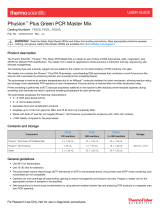
USER GUIDE Pub. No. MAN0017413 Rev. A.0
Invitrogen™ Lyo-ready Platinum™ SuperFi™ DNA Polymerase
Enzyme characteristics
Hot-start: Antibody
Length: Up to 20kb
Fidelity vs. Taq:>100X
Format: Separate components
PCR setup
Component 50-µL rxn Custom Final conc.
Water, nuclease-free to 50µL to µL —
5X SuperFi™ Buffer110µL µL 1X
10mM dNTP mix 1 µL µL 0.2mM each
10µM forward primer 2.5µL µL 0.5µM
10µM reverse primer 2.5µL µL 0.5µM
Template DNA2varies varies
5X SuperFi™ GC Enhancer (optional)310µL µL 1X
Lyo-ready Platinum™ SuperFi™ DNA
Polymerase (2U/µL) 0.5µL µL 0.02U/μL
1 Includes 7.5mM MgCl2.
2 5–50ng gDNA or 1pg–10ng plasmid DNA (see “Optimization strategies” for more
information).
3 Recommended for targets with >65% GC sequences. IMPORTANT! The SuperFi™ GC
Enhancer is not compatible with lyophilization.
PCR protocol
See page 2 and page 3 to prepare and run your PCR experiment.
Optimization strategies and troubleshooting
Click here for guidelines to optimize your PCR experiment.
Purchaser notification
Click here for Limited Warranty, Disclaimer, and Licensing information.
Contents Sample Kit No.
EP200SMP2
Size
500Units Kit contents
Storage
conditions ∤Store all contents at –20°C. Product is designed to withstand
at least 10 freeze-thaw cycles.
Required
materials
∤Template: gDNA, plasmid DNA, phage DNA, cDNA
∤Forward and reverse gene-specic primers
∤Invitrogen™ E-Gel™ General Purpose Gels, 1.2%
(Cat.No.G5018-01)
∤Invitrogen™ TrackIt™ 1kb Plus DNA Ladder
(Cat.No.10488-085)
∤0.2 or 0.5-mL nuclease-free microcentrifuge tubes
∤Gel loading buffer
∤Water, nuclease-free
Timing Varies depending on amplicon length.
Product
description
∤Invitrogen™ Lyo-ready Platinum™ SuperFi™ DNA Polymerase
combines superior proofreading enzyme properties and
compatibility with lyophilization. Lyo-ready enzyme
formulation contains minimal amount of glycerol (≤0.5%) and
retains all favorable standard Platinum™ SuperFi™ Polymerase
(with 50% glycerol) properties– exceptional delity, high
processivity, and resistance to common reaction inhibitors.
The combination of these features offers high exibility
in terms of lyophilized enzyme format that meets most
demanding performance requirements for detection assays.
∤Platinum™ hot-start technology inhibits DNA polymerase
activity at ambient temperatures, allowing room temperature
reaction setup and storage of pre-assembled PCR reactions
for up to 24hours prior to the PCR. Enzyme activity is
restored after the initial denaturation step.
∤Lyo-ready Platinum™ SuperFi™ DNA Polymerase has
5'to3'polymerase and 3'to5' exonuclease activities, but
lacks 5'to3' exonuclease activity. It produces blunt end DNA
products.
Important
guidelines Click here for important PCR guidelines.
Online
resources For further information, contact LCSVilnius@thermosher.com.
For Research Use Only. Not for use in diagnostic procedures.
Print Options

-2-
PCR procedure
The example PCR procedure below shows appropriate volumes for a single 50-µL reaction. For multiple reactions, prepare a master mix of components common to all reactions to
minimize pipetting error, then dispense appropriate volumes into each 0.2 or 0.5-mL PCR tube before adding template DNA and primers.
Step Action Procedure details
1 Thaw reagents Thaw, mix, and briey centrifuge each component before use.
2 Prepare PCR master mix
a. Add the following components to each PCR tube.
Note: Consider the volumes for all components listed in steps 2 and 3 to determine the correct amount of
water required to reach your nal reaction volume.
Component 50-µL rxn Final conc.
Water, nuclease-free to 50µL —
5X SuperFi™ Buffer110µL 1X
10mM dNTP mix 1µL 0.2mM each
5X SuperFi™ GC Enhancer (optional)210µL 1X
Lyo-ready Platinum™ SuperFi™ DNA Polymerase 0.5µL 0.02U/μL
1 Includes 7.5mM MgCl2.
2 Recommended for targets with >65% GC sequences.
b. Mix, then briey centrifuge the components.
3 Add template DNA and primers
a. Add your template DNA and primers to each tube for a nal reaction volume of 50μL.
Component 50-µL rxn Final conc.
10µM forward primer 2.5µL 0.5µM
10µM reverse primer 2.5µL 0.5µM
Template DNA1varies varies
1 Optimal amount of low-complexity DNA (plasmid, phage, BAC DNA) is 1pg–10ng per 50µL reaction, but it can be
varied from 0.1pg to 50ng per 50µL reaction. Optimal amount of genomic DNA is 5–50ng per 50µL reaction, but it
can be varied from 0.1ng to 250ng per 50µL reaction.
b. Cap each tube, mix, then briey centrifuge the components.

20 September 2018
For support, visit thermofisher.com/support.
-3-
Step Action Procedure details
4
Incubate reactions in a
thermal cycler
Step
2-step protocol (<10kb) 3-step protocol (<10kb) Long PCR (>10kb)
Temp. Time Temp.Time Temp. Time
Initial denaturation 98°C 30sec 98°C 30sec 95°C 2min
25–35
PCR
cycles
Denature 98°C 5–10sec 98°C 5–10sec 95°C 10sec
Anneal1— — varies 10sec varies 10sec
Extend 72°C 15–30sec/kb 72°C 15–30sec/kb 68°C 30sec/kb
Final extension 72°C 5min 72°C 5min 68°C 5min
4°C hold 4°C hold 4°C hold
1 IMPORTANT! Always use the Tm calculator on our website at thermosher.com/tmcalculator to calculate the Tm of your
primers and the recommended annealing temperature.
Note: Refer to “Optimization strategies”, page 1, for guidelines to optimize cycling conditions.
5
Add gel loading buffer and
analyze with gel
electrophoresis
a. Add gel loading buffer to 10µL of PCR product, mix, and briey centrifuge the contents.
b. Analyze the sample using agarose gel electrophoresis.
c. Use your PCR product immediately in down-stream applications, or store it at –20°C.
/









